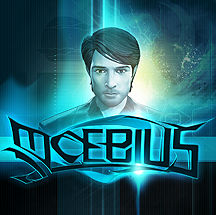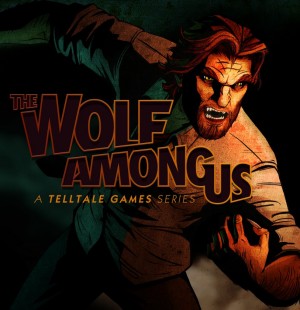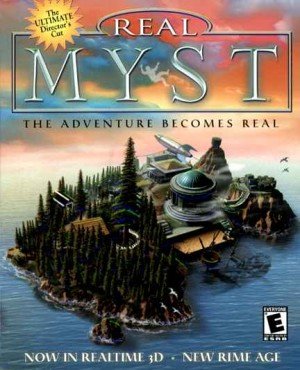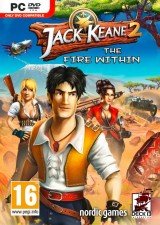Review for Nancy Drew: The Shattered Medallion page 2
If you haven’t had your fill of reality show entertainment recently, Nancy Drew’s 30th adventure, The Shattered Medallion, will give you a dose of scheming TV contestants as she gets to tackle the shark-infested waters of the reality adventure show, “Pacific Run.” Only, these sharks walk on two legs and plot alliances, race for clues, and even threaten to harm Nancy and her friends as they explore New Zealand. Though you’ll need to keep your wits about you for the abundance of engaging puzzles the game throws at you, in a departure from previous games, the wandering storyline is a weak point, and a mishmash of educational tidbits, reality show tropes, and a pinch of alien adventures can leave your head spinning.
This time around, Nancy isn’t jaunting off to help out a stranger. Instead, she comes to the aid of her good friend George Fayne. Being athletic and adventurous, George jumps at the chance to participate in a bout of televised competition on her favorite show. Unfortunately, she is quickly taken out of the competition under rather mysterious circumstances that Nancy will need to investigate, and Bess Marvin gets pulled in to help keep their team on the show. Bess, the group’s social butterfly, who would be more at home in a shopping mall or an ice cream shop batting her eyelashes at the local soda jerk, is most definitely not in her element here, despite her pink camouflage outfit. Anything athletic or not related to flirting with members of the opposite sex has her completely flummoxed.
Nancy, George, and Bess compete together against a variety of contestants, covering the gamut from married couples to siblings to boyfriends and girlfriends to just plain friends. One of the strengths of previous games has been the strong characterizations of their varied casts. On “Pacific Run”, however, Nancy seems to interact more with disembodied voices than she does with real characters. Although there are ten two-person teams competing in the show, Nancy only meets with two other teams face-to-face. The other teams only “appear” as voice recordings taken from a confession booth. The voice work for all is enjoyable, especially Bess, who chokes out in the confessional that she thinks she’s going to die but also manages to sound loopy and dreamy as she describes how she imagines a crush carrying a puppy. The confessions allow Nancy to listen in on some triumphs, but mostly tribulations, from the other teams that slowly get booted from the show. Then there is the narrator of the reality show, who strangely seems to be all-knowing, making small digs about the various contestants that she interviews. While these asides are all entertaining, they aren’t necessary for gleaning clues to help Nancy solve the multiple mysteries that slowly develop as she participates in the show.
Of course, because this is television, the “characters” you meet all have dramatic personas, and it seems that no one can be trusted to look out for anyone but themselves. Team Kea consists of the unlikely girlfriend/boyfriend duo of Leena and Patrick. Leena is clearly the brains of the pair, with a top secret background and a variety of skills, including code-breaking, that make her extremely overqualified to be in a reality show or to be Patrick’s girlfriend. Born in New Zealand, Patrick is a professional rugby player with a pair of overly philosophical parents. His meditative upbringing often has him struggling to articulate deep thoughts; almost, but never quite, making sense. At other times, he just seems to have gone off the deep end, offering people crackers when he doesn’t feel like talking, describing his life using a river metaphor, and constantly telling Nancy after saying something particularly ridiculous, “That’s a profound thought. Please write it down.”
Kiri, with her short, dark hair, intense gaze, and slender frame, is all coiled ambition. She has outlasted her partner and appears to be a reality show regular. Her background is in aerial acrobatics. One day, though, she realizes the absurdity of putting on spandex and mirrored glass-covered antlers day after day and decides to make a slightly less absurd living participating in these sorts of TV competitions. No stranger to how this type of show is played, she immediately tries to form an alliance with Nancy. In her own words, she is “a greyhound. Fame is a cruel sport. But I have a need to run.”
And of course a “reality” show must have a producer to help craft that reality. Sonny Joon, the show’s line producer, has a background shrouded in mystery, though he seems vaguely familiar to Nancy. As you play through the game, Nancy discovers stronger connections with Sonny via past mysteries. As if that weren’t odd enough, you’ll also find that Sonny has extracurricular activities outside of show producing that include contemplating extraterrestrials. Yes, aliens; you read that right. In a reality show. That’s a profound thought. You’ll want to make note of it.
Telegraphing his eccentricity, Sonny, with his spiky blue hair, never, ever gives you the straight story. Anytime Nancy talks to him, he sends you on riddle hunts, with non sequitur after non sequitur pouring from him as he winks knowingly behind his purple spectacles. And in what may be a series first, he’s the one man who has managed to get Bess completely tongue-tied, putting her patented Bess charm out of commission for the show. While Sonny seems to be a total space cadet at first glance, Nancy slowly begins to see patterns in his requests that hint at a larger mystery that goes beyond reality competition sabotage.
Once you’re settled in with Bess as your new loyal, but ditsy, sidekick, you’ll begin to explore your little corner of reality show paradise. The interface for the game has not changed or been updated from the previous outings. Inventory that you pick up, including books about sheep, exotic plants, gold prospecting equipment, and enigmatic comic book drawings, reside in a bar at the bottom of the screen. Nancy’s handy phone has been somewhat transformed into one that will only allow you to access messages from the show producers about upcoming competitive events. It still includes minigames (all the same ones returning players have encountered in previous games) that are entirely optional to play through. In addition to your phone, you have access to notes about your observations as well as a task list and layered hints on the easier difficulty level. For most puzzles, the hints eventually give you screenshots of the final solution. Despite this help, there are a few timed puzzles where even solution screenshots do nothing to help you finish, which can be quite frustrating. One timed puzzle involves navigating through the water in a kayak. To move forward in the competition, you will need to complete the puzzle within a certain amount of time. Even on the junior difficulty level with its shorter time to beat, I had to replay the sequence many times to beat the buzzer. And do you like mazes? Hopefully you do, as the game contains a maze that, while giving out directions for the maze in an integrated way, forces you to make fast decisions that test your reflexes.
Many of the other puzzles are built into the reality show framework. There are five locations you’ll be able to visit in the New Zealand area you are confined to for the competition. You come across clues to the various passwords that you will need before you can open up these locations. Each environment has a main puzzle you must solve before unlocking a medallion that will move you ahead in the competition. These puzzles start off simple, such as a straightforward train track puzzle where you have to swap misaligned tiles to connect the tracks. Some of the puzzles are extremely easy, like a word find puzzle and others that require you to make rows and columns add up to particular numbers. Others I found to just be tedious, such as a puzzle that had me replicating 3D shapes that had many, many facets. You need to do this to charge a piece of equipment, and I struggled to find any connection between making a duplicate of an image and charging something – and you have to do this puzzle every time you want to use that equipment. One puzzle toward the end has you replicating charms using an assembly line. You have to make these charms before the conveyor belt moves too far, and it was an exercise in pure frustration for me. I was ripping my hair out before it was over. Having said all that, there are a large variety of puzzles overall, with a wide range of difficulty for those who love to sit down to an adventure game chock full of brain teasers. There is also no shortage of trivia-based puzzles that will have you reading about everything from sheep shearing and farming to native New Zealand flora and the fish of the Fjordlands.
The artwork in this game hasn’t changed from previous outings. You are still moving through static, node-based scenes, and while the landscape in New Zealand can be quite pretty at times, including a lovely waterfront area with verdant hills and rocky mountains, this scenery is occasionally broken up by less-than-scenic tents, port-o-potties, and sound and stage equipment, reminding you that you’re watching a “reality” show. There are also a variety of native New Zealand wood carvings and totems peppered throughout the sets, all reinforcing the faux-reality, theme-park like environment Nancy finds herself in. In the middle area adjacent to the base camp where the players stay in tents is a large, primary-colored “Puzzle Palace.” It houses a variety of displays that share educational bits of information on such topics as volcanoes and earthquakes. From the Puzzle Palace to an abandoned gold mine and even a bunker housing a submarine, there are a good number of environments for you to explore.
There are some nice ambient sounds, including the bleating of sheep, the gentle slapping of water, and the chirping of birds. However, the music, with its soft violins, is entirely forgettable. There are a few nice cinematics in the game, with some of these even incorporated into puzzles, such as the river-rapid maze. And the characters are all nicely animated when you check in on them; Sonny will ply you with nonsensical sentences, keeping a straight, deadpan expression the entire time, and Kiri’s pinched features manage to convey manipulative power with a single arch of an eyebrow. However, you’ll spend the majority of the game in lonely exploration as the background animations are few and far between, and most of the contestants take up residence in the base camp and rarely move from there. It was difficult for me to suspend my disbelief at the fact that although Nancy was competing against nine other teams, you never saw anyone else in the Puzzle Palace, or during the kayak race, when several empty kayaks sat lonely at a dock with no one around to compete for them. You won’t get to see other competitors roaming the grounds, though you’ll occasionally hear disembodied voices as if they were just around the corner. Nancy only learns the results of other competitors’ progress by viewing a leaderboard, and by listening in to recordings of their confessions.
There are the obligatory Nancy Drew minigames as well, including a revisit of a game called Raid or Monster. These are entirely optional, but you can use them to win points to purchase souvenir items such as toy sheep and sunglasses from an in-game shop. The game doesn’t allow you to spend points in the store unless you have a minimum amount to start with, which makes sense as you’ll need a certain number of points remaining to “win” Pacific Run. As with other optional areas of the game, the developers reward you for interacting with the store in a particular way with an achievement. You will also encounter points cards as you explore, which allow you to either add points to your own score or take points away from other teams.
After about seven hours of exploration and reality show machinations, I found myself really questioning the story. Even as Nancy uses her sleuthing skills to suss out who had it in for George at the opening of the game, the larger mystery Nancy must eventually solve feels completely out of place. Just as so much of the drama in reality shows feels manufactured, the ultimate reason for why Nancy was even at this show feels entirely over-engineered, so much so that I was actually talking to my screen, saying, “Really? That’s the reason for this elaborate set-up?” The characters don’t help, as in this episode they are either stereotypes, nonentities, or quirky for the sake of being quirky. Is this a game about exploring New Zealand? About navigating the backstabbing and alliances of reality shows? Or one about alien beings and ancient relics (a theme we’d already visited in a previous game)? I can still hear Bess’s perplexed voice saying, “Don’t use your logic voice with me if you’re not going to use your logic …logic.” Typically I can just let myself go with the flow, but Nancy’s previous games with their strong characterizations and interesting storylines left me wanting so much more from this one. Still, if you’re looking for a variety of puzzles (there’s no shortage here) and don’t care about silly plots and characters, then Shattered Medallion may be a show you’ll want to put in your want-to-(though not must)-play queue.
























